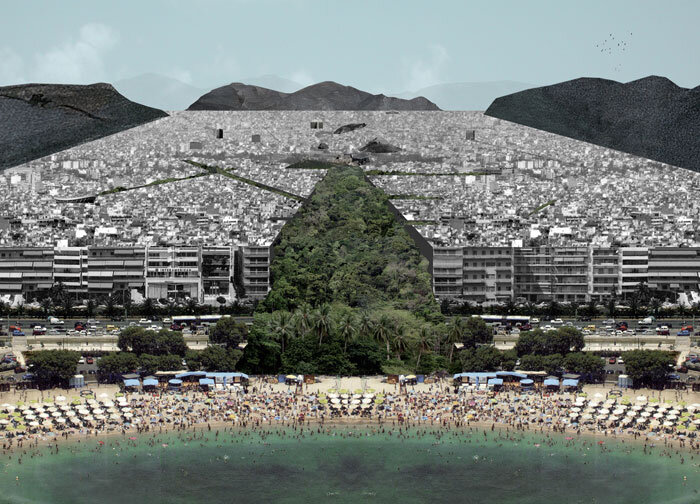Athens as an Urban Archipelagos
“The city historically constructed is no longer lived and is no longer understood practically. It is only an object of cultural consumption for tourists, for aestheticism, avid for spectacle and the picturesque.”[1] According to Lefebvre, it is impossible to still visualize the modes of construction taking place in the city as it was until then perceived. Rather, he envisions the city as a virtual object separated from the colossal and shapeless cluster of the preexisting fabric, calling for new approaches to take place within its shaping process. [Figure 1]
It is no secret that as the world’s population is growing, a steadily increased migration from rural to urban areas is taking place. Thus, the very own condition that made the concept of the metropolis to emerge during the 40’s, is gradually making us reconsider the design approaches we applied in the formation of the city. In our no so distance past and near future, those design approaches just focused on the idea of “sustainable architecture, itself rudimentary, often imposed an alternative lifestyle of renunciation, stripped of much pleasure.”[2]
Athens is the capital of Greece, having more than 3.500 years of existence. As a city of such age, it will serve as an ideal case study in the process of fully exploiting the significance of this newly developed need for a more ecological urban context. “There is only 2.7 m2 of green space attributed to each resident of Athens making it the most deprived of all European Capitals. In the most densely built central areas the percentage drops to a mere 0.4 m2 per person. How much additional green does the city require in order to reach the European average of 7 m2? How can this be placed in the city?”[3]
The Athenian case study is not just used as an example towards the implementation of a much-needed model of sustainability. Rather, this imposed concept alongside of ecological urbanism holds the capacity to undo, several major urban “obstacles”, such as the visual connection of the Acropolis hill to Athens seafront. As shown in figure2, buildings could be replaced with a strip of nature, linking the old (The Acropolis) with the new (Athenian Riviera), “constructing” the ecological coexist with the urban, making this simple strip of forest like intervention a servant in the process of blending different qualities which right now are being deprived.
By no means however these projects could ever be sucessfullt implemented, mainly due to their nature of intervening in such extend with the existing city fabric. However, besides indicators of social concern, they give clues about how the urban context could be mapped and altered in the not so distance future. They exploit a notion of separation from elements that informed our cities and hence the way we live, by highlighting the capacity of individual responsibilities versus group actions. In the case of Athens specifically however, ecological urbanism provides a theoretical framework, which if it is applied to the city-wide context prioritizes actions and concerns towards the near future. Striping down the layers of architecture added over the last decades, what remains identifiable and characterizes one neighborhood from another are the historic sites making ecological urbanism an invisible layer of infrastructure enabling this city to be identified and represented not by the proposed additions but rather from what was already there. [figure 3]
[1] M. Mostafavi. “Why Ecological Urbanism, Why Now?” in Ecological Urbanism. Baden, Switzerland: Lars
Muller, 2010: 23
[2] Ibid 13
[3] http://www.pointsupreme.com/content/research/athens-heaven.html

